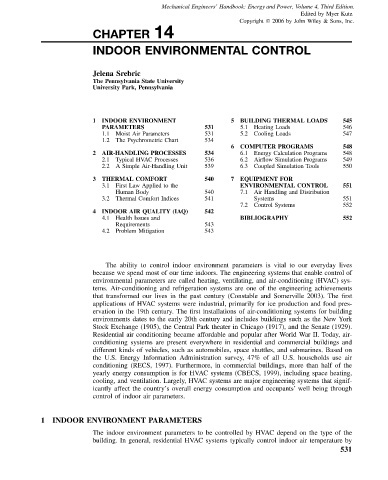Page 542 - Mechanical Engineers' Handbook (Volume 4)
P. 542
Mechanical Engineers’ Handbook: Energy and Power, Volume 4, Third Edition.
Edited by Myer Kutz
Copyright 2006 by John Wiley & Sons, Inc.
CHAPTER 14
INDOOR ENVIRONMENTAL CONTROL
Jelena Srebric
The Pennsylvania State University
University Park, Pennsylvania
1 INDOOR ENVIRONMENT 5 BUILDING THERMAL LOADS 545
PARAMETERS 531 5.1 Heating Loads 546
1.1 Moist Air Parameters 531 5.2 Cooling Loads 547
1.2 The Psychrometric Chart 534
6 COMPUTER PROGRAMS 548
2 AIR-HANDLING PROCESSES 534 6.1 Energy Calculation Programs 548
2.1 Typical HVAC Processes 536 6.2 Airflow Simulation Programs 549
2.2 A Simple Air-Handling Unit 539 6.3 Coupled Simulation Tools 550
3 THERMAL COMFORT 540 7 EQUIPMENT FOR
3.1 First Law Applied to the ENVIRONMENTAL CONTROL 551
Human Body 540 7.1 Air Handling and Distribution
3.2 Thermal Comfort Indices 541 Systems 551
7.2 Control Systems 552
4 INDOOR AIR QUALITY (IAQ) 542
4.1 Health Issues and BIBLIOGRAPHY 552
Requirements 543
4.2 Problem Mitigation 543
The ability to control indoor environment parameters is vital to our everyday lives
because we spend most of our time indoors. The engineering systems that enable control of
environmental parameters are called heating, ventilating, and air-conditioning (HVAC) sys-
tems. Air-conditioning and refrigeration systems are one of the engineering achievements
that transformed our lives in the past century (Constable and Somerville 2003). The first
applications of HVAC systems were industrial, primarily for ice production and food pres-
ervation in the 19th century. The first installations of air-conditioning systems for building
environments dates to the early 20th century and includes buildings such as the New York
Stock Exchange (1905), the Central Park theater in Chicago (1917), and the Senate (1929).
Residential air conditioning became affordable and popular after World War II. Today, air-
conditioning systems are present everywhere in residential and commercial buildings and
different kinds of vehicles, such as automobiles, space shuttles, and submarines. Based on
the U.S. Energy Information Administration survey, 47% of all U.S. households use air
conditioning (RECS, 1997). Furthermore, in commercial buildings, more than half of the
yearly energy consumption is for HVAC systems (CBECS, 1999), including space heating,
cooling, and ventilation. Largely, HVAC systems are major engineering systems that signif-
icantly affect the country’s overall energy consumption and occupants’ well being through
control of indoor air parameters.
1 INDOOR ENVIRONMENT PARAMETERS
The indoor environment parameters to be controlled by HVAC depend on the type of the
building. In general, residential HVAC systems typically control indoor air temperature by
531

